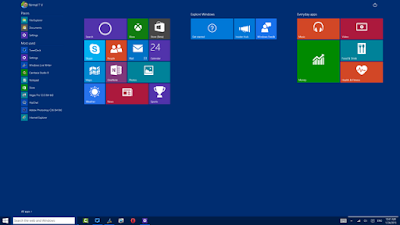Windows 10: All you commitment to know about sequence
With phones and tablets now regularly higher resolution screens than desktops and laptops, and are closing the achievement gap, and the lines between different computing devices are blurring. We have mobile phones and tablets that are much more powerful than the Microsoft Surface devices running ARM-based Windows RT.
(See also: Is it worth upgrading to Windows 10?)
People tend to forget that first touch OS was actually Microsoft Windows 7, which supported multi-touch screens natively, and even included gestures to zoom and navigation. It's hard to call Windows 7 touch-friendly by any stretch. That honor goes to Windows 8.
When Windows 8 went wrong
Windows 8 introduces a touch UI, but managed to do so in a way that made his traditional touch interface does not tedious. It is important to know that Windows 8 went wrong in understanding how Windows 10 does it well.
In short he felt Windows 8 operating system as a tablet and an operating system desktop hastily glued together. If you could pick one to start in the beginning they both do better. As it stands, though Microsoft integrates both aspects of the operating system enough to interfere with each other, but not far enough to work together.
He forced users to use mouse gestures and touch users to use the desktop. There are two ways of switching between applications interface of classic and modern user. The touch user interface could not work with the desktop and the desktop user interface may not work with touch applications.
When Windows 10 does well
Windows 10 introduces a new user experience that Microsoft called Continuum. The idea behind this is that not only Windows applications, but Windows itself must be able to adapt its interface to match the form factor and tickets are available on the device. Most importantly, you should be able to do this at runtime. So a mobile or tablet should be able to move between a touch user interface and desktop user interface smoothly.
(See also: All you need to know about Windows 10)
After all the mobile device does not care if the 1920 × 1080 pixels is pushing are a 5 "mobile screen 23" monitor or even a "TV 40. All that is required is that the interface to adapt to new screen dimensions and new forms of entry.
To this end users will notice a new button "tablet mode" when kicking click Continuum is the transformation of its user interface to better suit tablet touch-based. This transformation can be subtle in some cases, but is quite powerful.
Tablet Mode
You'll notice that the active window maximized to fill the entire screen. For the modern user interface applications including the title bar is hidden to give the highest priority to the content area.
In this mode you can run Windows in full screen, or break them side by side. If you already had cracked windows side by side, they will remain so, with the addition of a divider between them that allows you more space and then the other application.
The taskbar and the system tray erases all icons, search bar contracts for a single search icon and a new Back button appears next to the start button. The buttons do view and search buttons work the same, but adding back button allows you to navigate within and between applications that support it. Finally, the start menu now becomes a home screen, similar to that of Windows 8, but with some differences in the way it is designed.
If you still want to see the taskbar and icons in the system tray, Microsoft has you covered, you can enable these too.
Continuum extending support
Best of all, if your device is compatible, eliminating the keyboard of your notebook will automatically switch to tablet mode, while dock your tablet with a keyboard and mouse switch to the desktop user interface.
In fact, some of this is possible even with a mobile phone with Windows 10. Connecting to a desktop screen will allow you to run applications such as Microsoft Office compatible in, so desktop window, even from a phone. The phone can even become a touch keyboard and trackpad in this mode.
On the other hand, application developers developing desktop applications for Windows 10 can detect whether the tablet mode is engaged and change your user interface to one nice touch.
Continuum is not a new idea, but Microsoft is the first to have something to work in a way that can be used at this time, and just happens to work pretty well. With more support from application developers, only gets better with time.









No comments